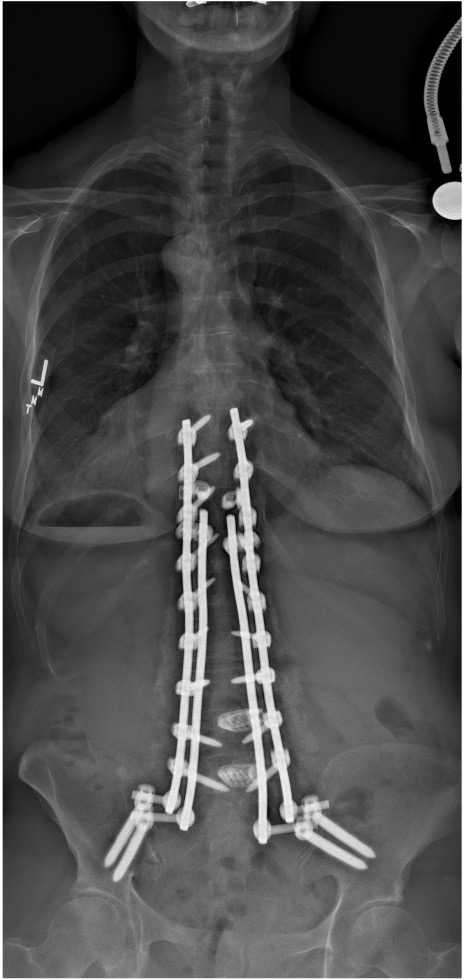
Patient with adult idiopathic scoliosis

Following surgical deformity correction
What is adult scoliosis and what causes it?
Scoliosis is a spinal deformity in which the spine curves when viewing it from the front, instead of being in a straight line. This condition can occur in all ages, but we primarily focus on caring for adults who develop this condition.
In adults, there are multiple types and causes of scoliosis. The most common cause is degenerative disease. Although it isn’t entirely clear how scoliosis develops with age and degenerative changes, it is thought that asymmetric (more one side than the other) degeneration of the discs between the spinal vertebra and the joints that connect these bones together leads to early curvature, which can then progress. This type of scoliosis most commonly affects the lumbar (lower back region) or the lower part of the thoracic (chest) region and is referred to as degenerative scoliosis or de novo (“out of no where”) scoliosis.
Adults may also present with scoliosis that is left over from when they were younger that was either not treated or perhaps treated but then developed further problems. The most common type of this scoliosis is termed adult idiopathic scoliosis. The most common type of scoliosis in children and adolescents is adolescent idiopathic scoliosis (AIS), which sometimes warrants spinal fusion depending on severity and rate of progression. Why AIS develops is unknown. Adults with a history of AIS from when they were younger may present with symptoms as their spines age and accumulate wear and tear. Adult idiopathic scoliosis most commonly affects the thoracic spine but not uncommonly affects both the thoracic and lumbar spine (double curves).
What are the symptoms?
Symptoms of adult scoliosis can vary but most commonly patients present with pain and disability. Pain often includes a combination of back and leg (“sciatica”) symptoms. Sometimes the scoliosis curve results in significant coronal imbalance (shifting of the spine/body off to one side) and may impact the patient’s ability to stand and walk without fatigue and pain. In some patients affected with adult scoliosis, there may be weakness due to compression of nerves or spinal cord.
How is Scoliosis diagnosed?
First, a brief history will be taken which includes the medical and family history of the patient, followed by a physical examination. Diagnostic tests, which include X-rays (and sometimes MRI and CT), will be completed to confirm the diagnosis, characterize the alignment measurements and to assess for areas of stenosis (narrowing) around nerves and spinal cord.
If you or a loved one are showing symptoms of scoliosis, do not wait. Talk to your physician or contact us through our website to make an appointment for an official diagnosis.
What treatment options are available?
In the absence of significant or progressive weakness or evidence of rapid worsening of deformity or alignment, most patients are encouraged to at least initially pursue a course of non-operative treatments with the hope that these will be sufficient in providing relief. These may include physical therapy, pool therapy, targeted steroid injections, and medications such as gabapentin or NSAIDs.
For patients who do not get satisfactory relief with non-operative treatments, surgery may be an option. Since surgeries for adult scoliosis tend to be fairly extensive with long recoveries and relatively high risk of complications, these procedures tend to be saved for those who cannot get sufficient relief with other treatments. The decision of whether to pursue operative treatment for adult scoliosis is often very personal. Patients must weigh the risks and benefits and should have an open discussion with their surgeon. The good news is that clinical research studies have shown the potential for surgery to provide significant improvement in pain and function for patients with adult scoliosis.
If you or a loved one is suffering from scoliosis, talk to your surgeon or contact us to set up an appointment.

